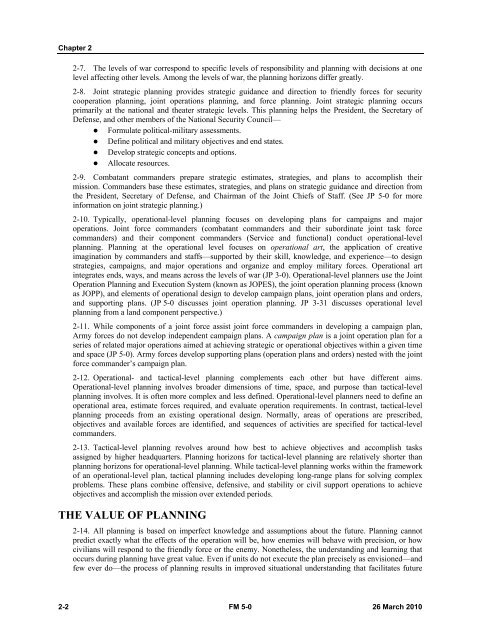FM 5-0, The Operations Process - Federation of American Scientists
FM 5-0, The Operations Process - Federation of American Scientists
FM 5-0, The Operations Process - Federation of American Scientists
Create successful ePaper yourself
Turn your PDF publications into a flip-book with our unique Google optimized e-Paper software.
Chapter 2<br />
2-7. <strong>The</strong> levels <strong>of</strong> war correspond to specific levels <strong>of</strong> responsibility and planning with decisions at one<br />
level affecting other levels. Among the levels <strong>of</strong> war, the planning horizons differ greatly.<br />
2-8. Joint strategic planning provides strategic guidance and direction to friendly forces for security<br />
cooperation planning, joint operations planning, and force planning. Joint strategic planning occurs<br />
primarily at the national and theater strategic levels. This planning helps the President, the Secretary <strong>of</strong><br />
Defense, and other members <strong>of</strong> the National Security Council—<br />
• Formulate political-military assessments.<br />
• Define political and military objectives and end states.<br />
• Develop strategic concepts and options.<br />
• Allocate resources.<br />
2-9. Combatant commanders prepare strategic estimates, strategies, and plans to accomplish their<br />
mission. Commanders base these estimates, strategies, and plans on strategic guidance and direction from<br />
the President, Secretary <strong>of</strong> Defense, and Chairman <strong>of</strong> the Joint Chiefs <strong>of</strong> Staff. (See JP 5-0 for more<br />
information on joint strategic planning.)<br />
2-10. Typically, operational-level planning focuses on developing plans for campaigns and major<br />
operations. Joint force commanders (combatant commanders and their subordinate joint task force<br />
commanders) and their component commanders (Service and functional) conduct operational-level<br />
planning. Planning at the operational level focuses on operational art, the application <strong>of</strong> creative<br />
imagination by commanders and staffs—supported by their skill, knowledge, and experience—to design<br />
strategies, campaigns, and major operations and organize and employ military forces. Operational art<br />
integrates ends, ways, and means across the levels <strong>of</strong> war (JP 3-0). Operational-level planners use the Joint<br />
Operation Planning and Execution System (known as JOPES), the joint operation planning process (known<br />
as JOPP), and elements <strong>of</strong> operational design to develop campaign plans, joint operation plans and orders,<br />
and supporting plans. (JP 5-0 discusses joint operation planning. JP 3-31 discusses operational level<br />
planning from a land component perspective.)<br />
2-11. While components <strong>of</strong> a joint force assist joint force commanders in developing a campaign plan,<br />
Army forces do not develop independent campaign plans. A campaign plan is a joint operation plan for a<br />
series <strong>of</strong> related major operations aimed at achieving strategic or operational objectives within a given time<br />
and space (JP 5-0). Army forces develop supporting plans (operation plans and orders) nested with the joint<br />
force commander’s campaign plan.<br />
2-12. Operational- and tactical-level planning complements each other but have different aims.<br />
Operational-level planning involves broader dimensions <strong>of</strong> time, space, and purpose than tactical-level<br />
planning involves. It is <strong>of</strong>ten more complex and less defined. Operational-level planners need to define an<br />
operational area, estimate forces required, and evaluate operation requirements. In contrast, tactical-level<br />
planning proceeds from an existing operational design. Normally, areas <strong>of</strong> operations are prescribed,<br />
objectives and available forces are identified, and sequences <strong>of</strong> activities are specified for tactical-level<br />
commanders.<br />
2-13. Tactical-level planning revolves around how best to achieve objectives and accomplish tasks<br />
assigned by higher headquarters. Planning horizons for tactical-level planning are relatively shorter than<br />
planning horizons for operational-level planning. While tactical-level planning works within the framework<br />
<strong>of</strong> an operational-level plan, tactical planning includes developing long-range plans for solving complex<br />
problems. <strong>The</strong>se plans combine <strong>of</strong>fensive, defensive, and stability or civil support operations to achieve<br />
objectives and accomplish the mission over extended periods.<br />
THE VALUE OF PLANNING<br />
2-14. All planning is based on imperfect knowledge and assumptions about the future. Planning cannot<br />
predict exactly what the effects <strong>of</strong> the operation will be, how enemies will behave with precision, or how<br />
civilians will respond to the friendly force or the enemy. Nonetheless, the understanding and learning that<br />
occurs during planning have great value. Even if units do not execute the plan precisely as envisioned—and<br />
few ever do—the process <strong>of</strong> planning results in improved situational understanding that facilitates future<br />
2-2 <strong>FM</strong> 5-0 26 March 2010















